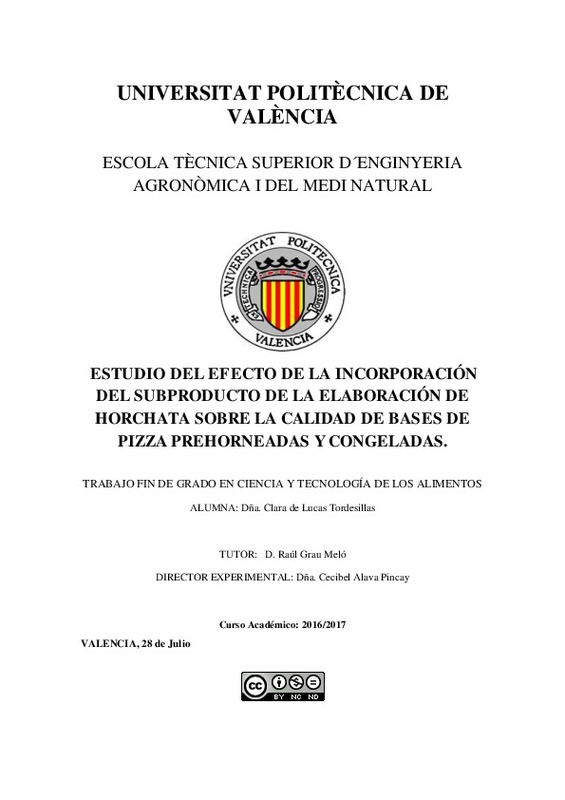|
Resumen:
|
[ES] En el presente estudio se ha evaluado el efecto de la incorporación de dos tipos de salsa
modelo, una acuosa (tomate) y una grasa (nata), y del tiempo de horneado (segundo
horneado) sobre bases de pizza prehorneadas ...[+]
[ES] En el presente estudio se ha evaluado el efecto de la incorporación de dos tipos de salsa
modelo, una acuosa (tomate) y una grasa (nata), y del tiempo de horneado (segundo
horneado) sobre bases de pizza prehorneadas y congeladas que han sido elaboradas con
sustitución parcial de harina de trigo por harina procedente del subproducto de la elaboración
de horchata. Para ello se acondicionó el subproducto obteniendo dos harinas que se
incorporaron a la elaboración de bases de pizza, sustituyendo la harina de trigo en un 20 %, a
partir de estudios anteriores. Las variables que se evaluaron fueron la adición de dos tipos de
salsas, en función del grado de grasa de éstas, y el tiempo de horneado sobre el producto final
horneado. Los resultados obtenidos han mostrado como el tipo de salsa adicionada a la pizza
influye sobre las características de éstas, fundamentalmente debido al contenido de agua. Si
bien la incorporación de salsa de tomate incrementa inicialmente el contenido en agua, son las
elaboradas con nata las que al final presentan mayor cantidad de agua, generando pizzas más
blandas, pero sensorialmente mejor valoradas dado que la nata enmascara la fibra añadida.
Así mismo, el tiempo de horneado resultó ser muy influyente, pudiéndose establecer en base
al estudio un tiempo aproximado de entre 15 y 20 minutos de segundo horneado. Finalmente,
la utilización de distintos formatos de harina procedentes del subproducto de la elaboración
de horchata genera cambios con respecto a pizzas elaboradas solo con harina de trigo, si bien
en base a las respuestas dadas por los catadores, el uso del subproducto triturado los
minimiza.
[-]
[EN] In the present work we study the effect of the incorporation of two types of model sauce, an
aqueous (tomato) and a fat (cream), and the time of baking (second baking) on pre-baked and
frozen pizza bases which have ...[+]
[EN] In the present work we study the effect of the incorporation of two types of model sauce, an
aqueous (tomato) and a fat (cream), and the time of baking (second baking) on pre-baked and
frozen pizza bases which have been made with partial substitution of wheat flour for flour
from the by-product of horchata elaboration. In order to do this, the by-product was prepared
to obtain two flours that were incorporated in the production of pizza bases. These two flours
replaced wheat flour by 20% and the amount of replacement was built on previous studies.
The evaluated variables were the addition of two types of sauces, depending on the degree of
fat of these, and the time of baking on the final baked product. The results obtained have
shown how the type of sauce added to the pizza influences the characteristics of these, mainly
due to the water content. Although the incorporation of tomato sauce initially increases the
water content, it is the ones made with whipped cream that in the end present a greater
amount of water, generating softer pizzas, but despite of this, being better valued in the
sensory analysis since the cream masks the added fiber. Also, the baking time was very
influential, we were able to establish based on the study an approximate time of between 15
and 20 minutes of cooking. Finally, the use of different forms of flour from the by-product of
horchata elaboration generates changes with respect to pizzas made only with wheat flour,
although based on the answers given by the tasters, the use of the crushed by-product
minimizes them.
[-]
|







